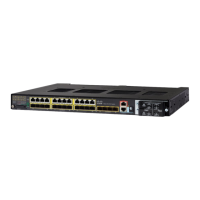662
Configuring IPv6 Host Functions
How to Configure IPv6 Hosting
Default IPv6 Settings
How to Configure IPv6 Hosting
Configuring IPv6 Addressing and Enabling IPv6 Host
This section describes how to assign IPv6 addresses to individual Layer 3 interfaces and to globally forward IPv6 traffic
on the switch.
Before configuring IPv6 on the switch, consider these guidelines:
Be sure to select a dual IPv4 and IPv6 SDM template.
In the ipv6 address interface configuration command, you must enter the ipv6-address and ipv6-prefix variables
with the address specified in hexadecimal using 16-bit values between colons. The prefix-length variable (preceded
by a slash [/]) is a decimal value that shows how many of the high-order contiguous bits of the address comprise
the prefix (the network portion of the address).
To forward IPv6 traffic on an interface, you must configure a global IPv6 address on that interface. Configuring an IPv6
address on an interface automatically configures a link-local address and activates IPv6 for the interface. The configured
interface automatically joins these required multicast groups for that link:
solicited-node multicast group FF02:0:0:0:0:1:ff00::/104 for each unicast address assigned to the interface (this
address is used in the neighbor discovery process.)
all-nodes link-local multicast group FF02::1
all-routers link-local multicast group FF02::2
For more information about configuring IPv6, see the “Implementing Addressing and Basic Connectivity for IPv6” chapter
in the Cisco IOS IPv6 Configuration Library on Cisco.com.
Feature Default Setting
SDM template Default.
IPv6 addresses None configured.
Command Purpose
1. configure terminal Enters global configuration mode.
2. sdm prefer dual-ipv4-and-ipv6 default Selects the SDM template that supports IPv4 and IPv6.
3. end Returns to privileged EXEC mode.
4. reload Reloads the operating system.
5. configure terminal Enters global configuration mode after the switch reloads.
6. interface interface-id Enters interface configuration mode, and specifies the interface
to configure.

